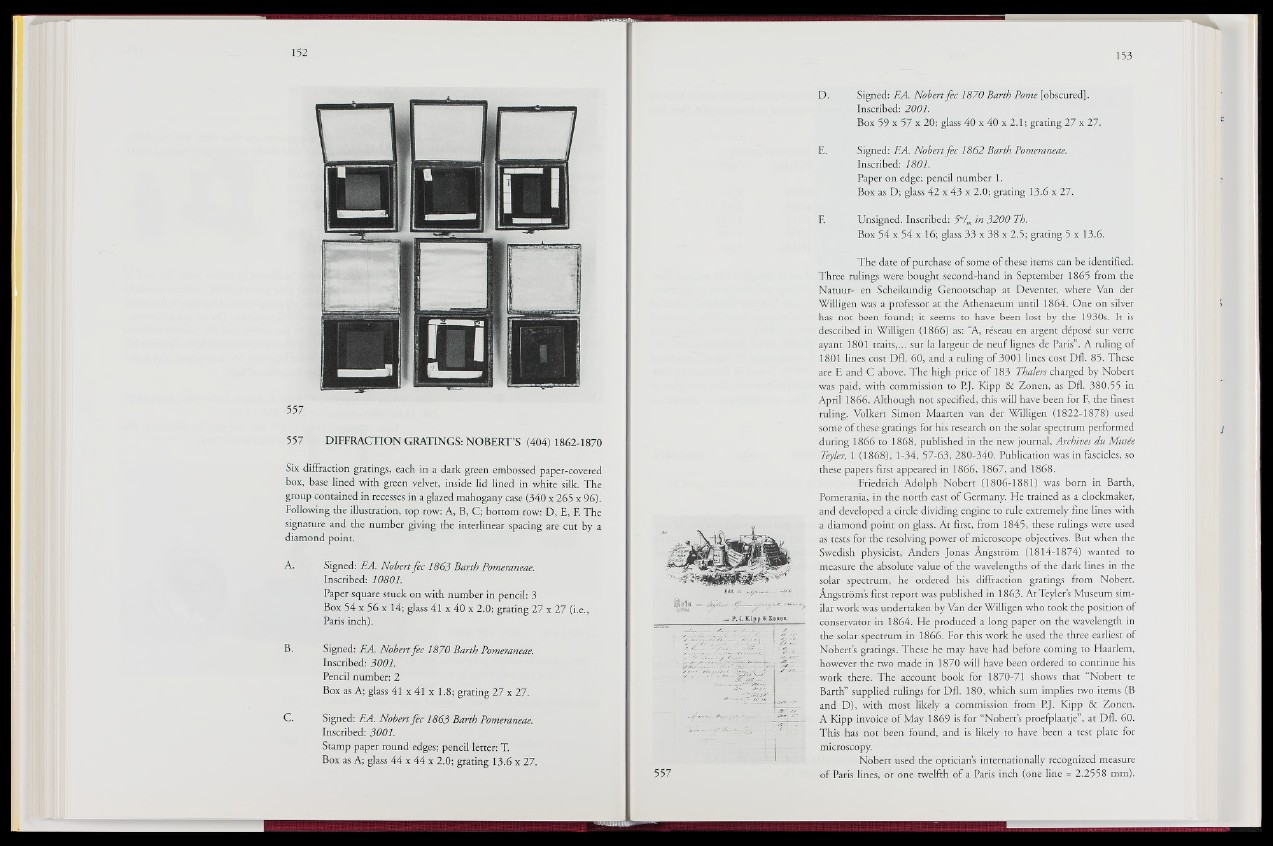
557
557 DIFFRACTION GRATINGS: NOBERT’S (404) 1862-1870
Six diffraction gratings, each in a dark green embossed paper-covered
box, base lined with green velvet, inside lid lined in white silk. The
group contained in recesses in a glazed mahogany case (340 x 265 x 96).
Following the illustration, top row: A, B, C; bottom row: D, E, F. The
signature and the number giving the interlinear spacing are cut by a
diamond point.
A. Signed: F.A. Nobert fee 1863 Barth Pomeraneae.
Inscribed: 10801.
Paper square stuck on with number in pencil: 3
Box 54 x 56 x 14; glass 41 X 40 X 2:0: grating 27 x 27 (i.e.,
Paris inch).
B. Signed: PA. Nobert fee 1870 Barth Pomeraneae.
Inscribed: 3001.
PentSlnumber: 2
Box as A; glass 41 x 41 x 1.8; grating 2||ix 27.
C. Signed: PA. Nobert fee 1863 Barth Pomeraneae.
Inscribed: 3001.
Stamp paper round edges; pencil letter: T.
Box as A; glass 44 x 44 x 2.0; grating 13.6 x 27.
D. Signed: F.A. Nobert fee 1870 Barth Pome [obscured].
Inscribed: 2001.
Box 59 x 57 x 20; glass 40 x 40 x 2.1; grating 27 x 27.
E. Signed: F.A. Nobert fee 1862 Barth Pomeraneae.
Inscribed: 1801.
Paper on edge; pencil number 1. j i
Box as D; glass 42 x 43 x 2.0; grating 13.6 x 27.
F. Unsigned. Inscribed: 5"/m in 3200 Th.
Box 54 x 54 x 16; glass 33 x 38 x 2.5; grating 5 x 13.6.
The date of purchase of some of these items can be identified.
Three rulings were bought second-hand in September 1865 from the
Natuur- en Scheikundig Genootschap at Deventer, where Van der
Willigen was a professor at the Athenaeum until 1864. One on silver >
has not been found; it seems to have been lost by the 1930s. It is
described in Willigen ( 1866) as:-“A, réseau en argent déposé sur verre
ayant 1801 traiti,,.. sur la largeur de neuf lignes de Paris”. A ruling of
180Mines cost Dfl. 60, and a ruling of 3001 lines cost D’fl. 85. These
are E and C above. The high price of 183 Thalers charged bjjNobert
was paid, with commission to P.J. Kipp & Zonen, as Dfl. 380.55 in
April 1866. Although not specified, this will have been for F, the finest
ruling. Volkert Simon Maarten van der Willigen (1822-1878) used
some of these gRfiings for his research on the solar spectrum performed j
during 1866 to 1868, published in the new journal, Archives du Musée
Teyler, 1 (1868), l-:j§| 57-63s$|80-340. Publication was in fascicles, so
these papers f is t appeared in 1866, 1867, and 1868.
Friedrich Adolph Nobert (1806-1881) was born in Barth,
Pomerania, in the north east of Germany. He trained as a dockmaker,
and developed a qflsla dividing engine to rule extremely fine lines with
a diamond point on glass. At first, from 1845, these.rulings were used
as tests for the resolving power of microscope objectives. But when the
Swedish physicist, Anders Jonas Angstrom (1814-1874). wanted to
tncasuri-ï the absolute valudidf the wavelengths of the dark lines in thè
solar spectrum, he ordered his diffraction gratings from Nobert.
Angstroms first report was publilhed in 1863. AtTeyler’s Museum similar
work was undertaken by Van der Willigen who took the position of
conservator in 1864. He produced a long paper on the wavelength in
the solar spectrum in 1866. For this work he used the three earliest of
JJobert’s gratings. These he may have had before coming to Haarlem,
however the two made in 1870 will have been ordered to continue his
work there. The account book for 1870-7OTshows that “Nobert te
Barth” supplied rulings for Dfl. 180, which sum implies two items (B
S id D), with most likely a commission from P.J. Kipp & Zonen.
A Kipp invoice of May 1869 is for “Nobert sproefplaatje”, at Dfl. 60.
This has not been found, and is likely to have been a test plate for
microscopy.
Nobert used the optician’s internationally recognized measure
of Paris lines, or one twelfth of a Paris inch (one line = 2.2558 mm).